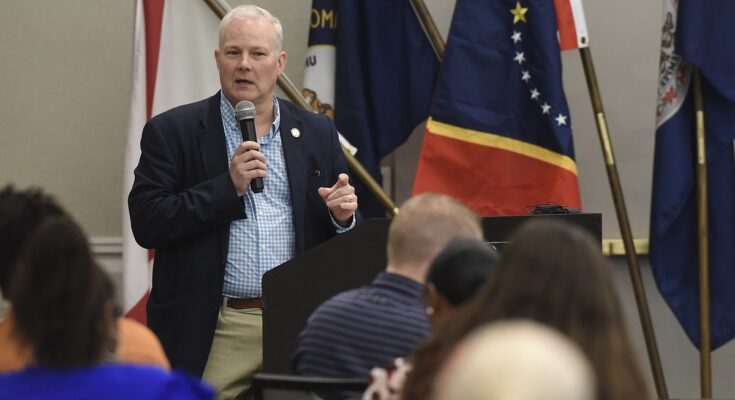Inmates are using contraband cell phones to coordinate criminal activity inside and outside of prisons, Arkansas Attorney General Tim Griffin said Friday, as he pushed for federal legislation allowing states to jam the devices inside correctional facilities.
Griffin, speaking to the Southern States Correctional Association conference in Little Rock, told corrections department employees from around the South that they need to push for passage of the Cell Phone Jamming Reform Act.
The bill, currently under consideration in the U.S. Senate subcommittee on Commerce, Science and Transportation, would give states the power to block most cell phones from being used inside prisons and stop the Federal Communications Commission from prohibiting the jamming efforts. The measure, sponsored by U.S. Sen. Tom Cotton, R-Ark. , failed to pass in 2024.
Griffin said 230 of the “serious threat group leaders” in Arkansas prisons — including members of Aryan Nations, white supremacists and Gangster Disciples — have been found to have used contraband cell phones.
“It’s shocking,” Griffin said. “These are the worst of the worst. They are assigning hits, dealing drugs, doing all the things they were doing on the outside on the inside, because they have cell phones.”
Cotton, in a short video, told corrections officials from a dozen states stretching from West Virginia to Texas, that the problem of contraband cell phones in prisons has led to sextortion schemes being run by inmates in North Carolina and South Carolina and a drug ring importing meth to the Atlanta area.
“The bottom line is contraband cell phones pose a serious risk,” Cotton said.
Jamming cell phones is currently prohibited under federal law because the equipment can interfere with 911 calls and hamper first responders.
The Urban Institute surveyed 20 states in 2020 and found that more than 25,000 cell phones were recovered from state prisons. But the number seized state-by-state varies, with some reporting less than 20 seized, while other states reported more than 6,000 taken.
Griffin, who asked conference attendees to contact their Congressmen and Senators about the measure, said jamming cell phones inside the state’s prisons would help prevent inmates from coordinating escapes and other crimes.
He cited the dramatic escape of Samuel Hartman, who was serving a life sentence for the rape of a 14-year-old girl when he fled from a work detail in a field near the East Arkansas Regional Unit located in Brickeys on Aug. 11, 2022.
“He was helped by his mother and his wife,” Griffin said. “They picked him up in a bullet proof car. It looked like steel in it or something.”
The trio used jet skis to get down the Arkansas River before disappearing and being caught several weeks later in West Virginia.
“This is not a movie, folks,” Griffin said. “The solution is to jam these phones.”
Prison officials in South Carolina have been experimenting with the technology, and in 2023 started a pilot program to deactivate cell phones found in Lee Correctional Institution east of Columbia, S.C., where a riot five years earlier resulted in seven inmate deaths and 22 people being taken to the hospital.
Prison officials said contraband cell phones contributed to the violence.
The telecommunications industry, through it’s lobbying arm CTIA and others, have been cautious about adopting jamming technology in prison over concerns it could impact neighboring communities. But the group has been open to finding a way to allow the jamming without impacting outside phones.
Griffin said the technology exists to target just contraband phones inside prisons and exempt the phones of staff members.
“I am told the technology is … there,” Griffin said. “You can target their specific prefixes, codes, you can do geofixing, where you jam an area. There are a lot of ways to fine tune this.”


